Book contents
- Frontmatter
- Dedication
- Contents
- Preface
- For the Instructor
- Part I Preliminaries
- Part II Preprocessing
- Part III Image Understanding
- Part IV The 2D Image in a 3D World
- A Support Vector Machines
- B How to Differentiate a Function Containing a Kernel Operator
- C The Image File System (IFS) Software
- Author Index
- Subject Index
- References
Preface
Published online by Cambridge University Press: 25 October 2017
- Frontmatter
- Dedication
- Contents
- Preface
- For the Instructor
- Part I Preliminaries
- Part II Preprocessing
- Part III Image Understanding
- Part IV The 2D Image in a 3D World
- A Support Vector Machines
- B How to Differentiate a Function Containing a Kernel Operator
- C The Image File System (IFS) Software
- Author Index
- Subject Index
- References
Summary
This book introduces the fundamental principles of Computer Vision to the advanced undergraduate or first-year graduate student in mathematics, computer science, or engineering.
The book is deliberately informal. The authors attempt to keep the student interested and motivated to continue reading. The student is often addressed directly, as if the student and the authors were in a classroom together. The style is somewhat casual, the authors use the first person frequently, the passive voice is seldom used, and the occasional joke may appear.
The foundations described in the title of this book take two forms: mathematical principles and algorithmic concepts. The principles and concepts are taught together, by describing a computer vision problem, e.g., segmentation, describing an algorithm that could solve that problem, and explaining the mathematical principles underlying the algorithm.
These mathematical principles include
Linear Operators Taught through a variety of applications, including:
Basis Functions Taught through edge detectors
Gaussian Convolution Taught through development of Gaussian edge kernels
Constrained Optimization Taught through finding optimal edge detection kernels and through principal components
The Pseudoinverse Taught through explaining photometric stereo
Scale Taught through development of Gaussian edge kernels.
Nonlinear Operators Taught through mathematical morphology.
Effects of Sampling Taught by illustrating the use of small kernels for determining orientation.
Use of Optimization Taught through development of noise removal algorithms, adaptive contours for segmentation and graph cuts.
Use of Consistency Taught through Hough-like algorithms, through shape matching, and projection onto a manifold.
Projective Geometry Taught through shape from motion and shape from X algorithms.
These concepts are organized in a progression of levels, moving from pixel-level operations such as noise removal, through edge detection, segmentation, and shape description, and finally to recognition. At each level in the progression, the student learns what specific terminology means, what a good application of the concept to an image does, and one or more approaches to solving the application problem.
Almost all the images used as examples in the book are available for download. When one of these figures is used, the figure caption gives the name of the image.
- Type
- Chapter
- Information
- Fundamentals of Computer Vision , pp. xiii - xivPublisher: Cambridge University PressPrint publication year: 2017

